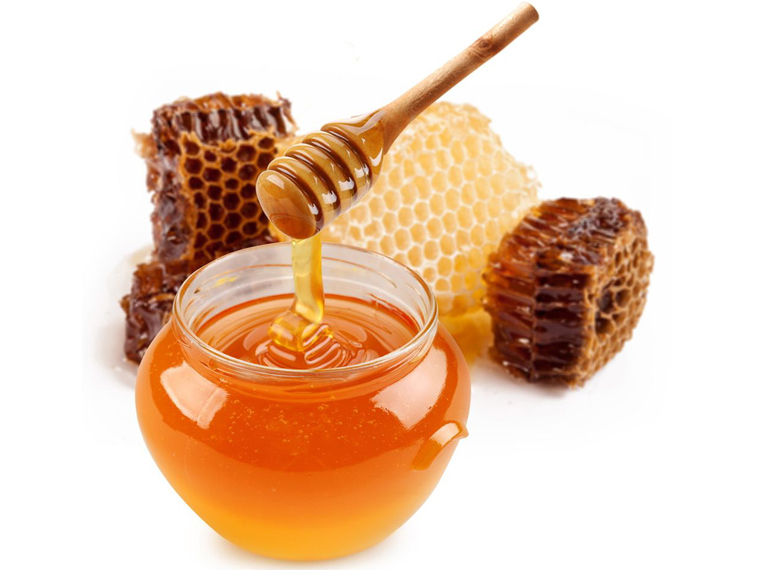
We are regularly advised to cut our consumption of sweet foods, but there’s something special about honey. Honey is the unique product of swarms of bees that cover a six-mile radius during nectar collection. Anything that takes so much work to make must be good! Honey is sweeter than sugar, with 65 calories per tablespoon, as opposed to white sugar’s 48. Calories apart it has some surprising health benefits.
What’s it good for?
- acne
- age sports
- allergies
- coughs
- insomnia
- laryngitis
- peptic ulcers
- sore throat
Honey is not a nutritional powerhouse. It contains trace amounts of B vitamins, amino acids and minerals, but it’s really no more nutritious than plain sugar. If honey gets attention from doctors, it’s for other reasons. Its thick syrupy texture makes it a natural for easing sore throat pain, especially when it’s added to hot lemon or a soothing tea such as chamomile.
But honey does much more. It kills bacteria and helps cuts and wounds to heal faster. It is a natural laxative. It appears to reduce the pain of stomach ulcers. And it is a quick-acting energy source that can reinvigorate tired muscles faster than you can say ‘Lucozade sport’. Scientists have actually found that athletes perform better when they eat a little honey.
A sweet antiseptic
Infection was the greatest health threat in the days before antibiotics. Even small cuts or grazes could turn deadly, which why doctors often carried a little honey in their black bags. Honey contains hydrogen peroxide and propolis, a compound in nectar that kills bacteria. Even today, when antiseptic creams are found in every medicine cabinet, some doctors believe that honey might be a superior wound dressing in some cases. Indeed, it works so well that a number of manufacturers sell honey-impregnated dressing for hard-to-hard wounds.
The high sugar content of honey pulls moisture from wounds and denies bacteria the moisture they need to survive. It also locks out harmful external contaminants. And because honey is inexpensive, it can be the ideal choice in countries without access to modern wound creams.
Where honey comes from
Bees sip a little nectar when they make their flowery rounds, but they carry most of it back to the hive and stash it in the hexagonal wax cells of the honeycomb to nourish young bees. The liquid nectar turns into honey when moisture evaporates. The finished product is mainly sugars – fructose and dextrose – plus a little bit of pollen, wax, proteins, vitamins and minerals. The clover honey that occupies most of the shelves in supermarkets is the blandest variety. More flavoursome honeys come from lavender, citrus blossoms and raspberry flowers.
Back in the 1970s surgeons reported that women who had gynaecological surgery had shorter hospital stays and showed no signs of infection when incisions were coated with honey. Studies in India show that burns dressed with honey heal more quickly and with less pain and scarring than burns coated with silver sulphadiazine, a conventional burn treatment.
Honey has even been used to treat superficial eye problems, including conjunctivitis and chemical burns. In a study of more than 100 patients with eye disorders that didn’t respond to conventional treatments, doctors tested a honey ointment. Eighty-five per cent of cases responded and improvement. Applying honey to the eyes (don’t do it without asking your doctor first) may cause a brief stinging sensation and some redness, but is unlikely to cause other side effects.
Sweet digestion
Traditional healers used honey to treat a variety of gastro-intestinal complaints. Now there’s good evidence that it works.
For example:
- It soothes stomach ulcers Honey may reduce ulcer symptoms and speed up the healing time. Honey appears to reduce inflammation, stimulate bloodflow and enhance the growth of epithelial cells, the ones exposed along the interior of the stomach or intestine. Studies have also shown that honey kills H. pylori, the bacterium responsible for most ulcers. Raw honey (from farm shops or farmers’ markets) is probably the best choice as high-heat processing used to create pasteurized honey may neutralize some of the active compounds. A form of honey called Active Manuka Honey, produced in New Zealand from the manuka tree and available in health-food stores, appears to be more effective than other types.
- It promotes regularity Honey’s high concentration of fructose makes it just the thing for occasional constipation. Undigested fructose provides nourishment for normal intestinal bacteria. The resulting fermentation brings water into the large intestine and has a laxative effect.
A word of warning
Never give honey to children under the age of 1, as it may contain a small number of spores called Clostridium botulinum, the organism that causes botulism. The spores don’t thrive in the intestines of adults and older children. But they are able to multiply in babies, possibly causing a serious form of food poisoning known as infant botulism.
